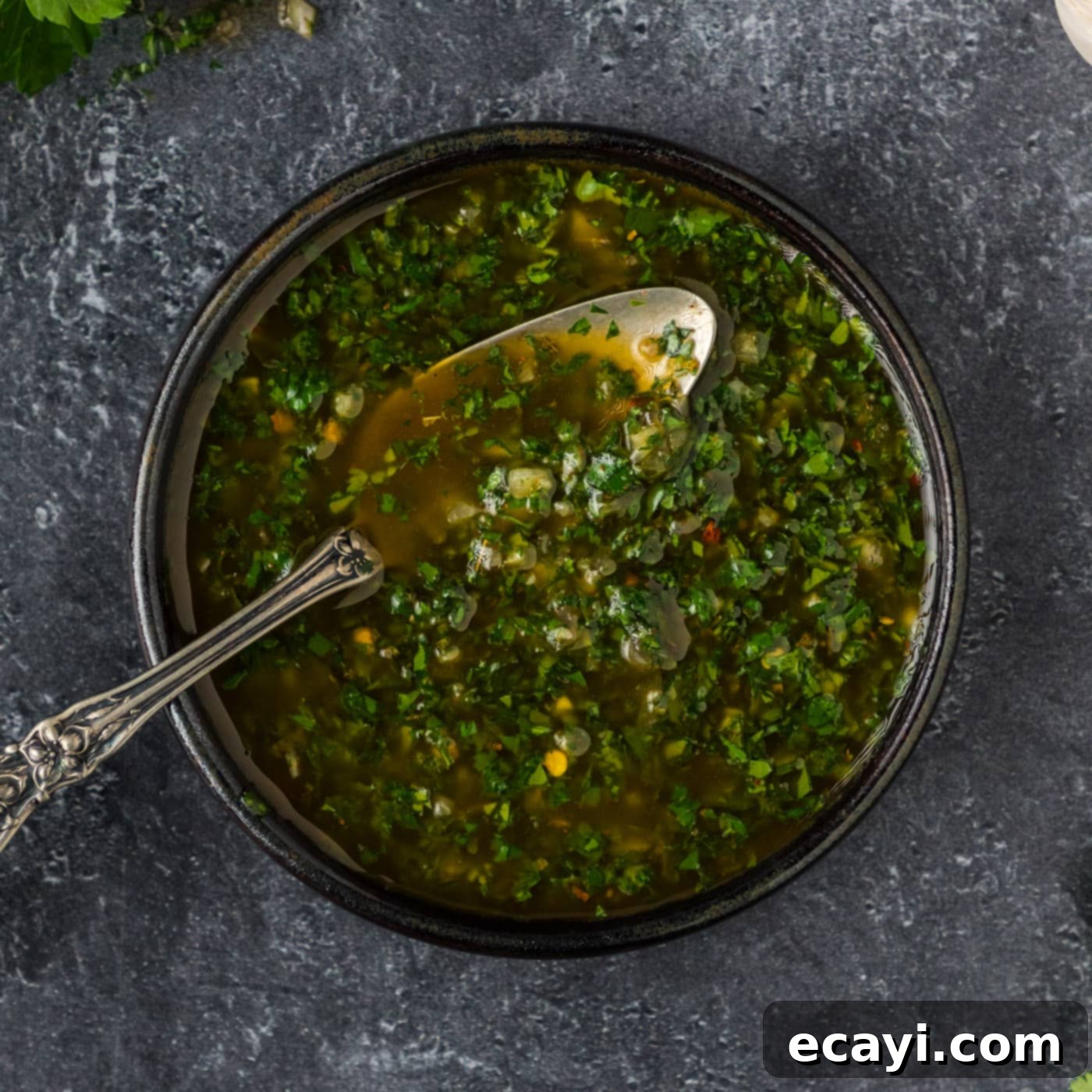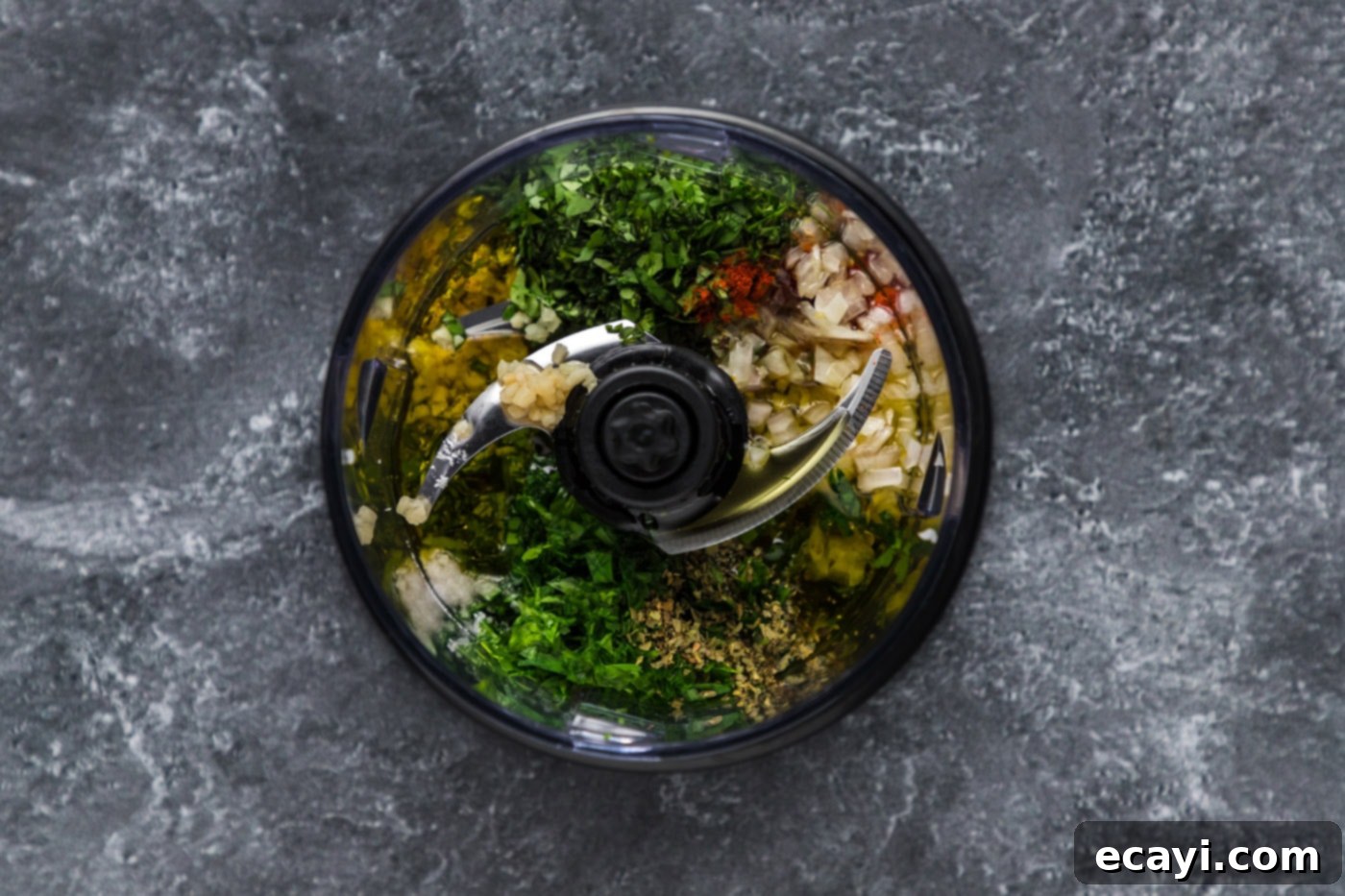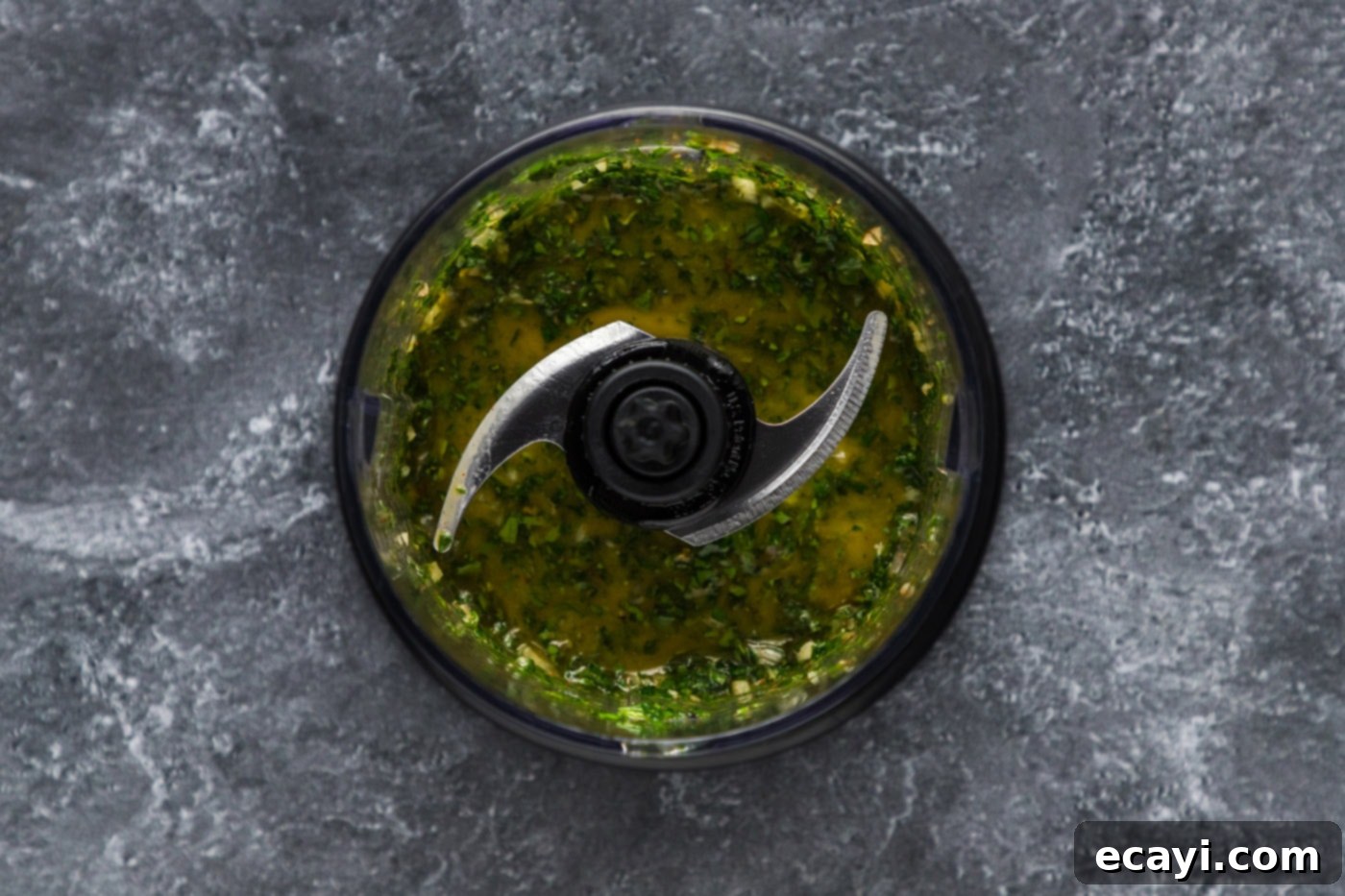Authentic Homemade Chimichurri Recipe: Your Guide to Fresh, Flavorful Sauce
This vibrant and incredibly fresh homemade chimichurri sauce is a culinary masterpiece, bursting with herbaceous flavor and a zesty tang. Best of all, it comes together in under 5 minutes with a quick blitz in your food processor. Forget store-bought versions; this easy recipe delivers an authentic taste that will elevate any meal, from grilled meats to roasted vegetables and even simple crusty bread. Get ready to awaken your taste buds with this bright and bold condiment!
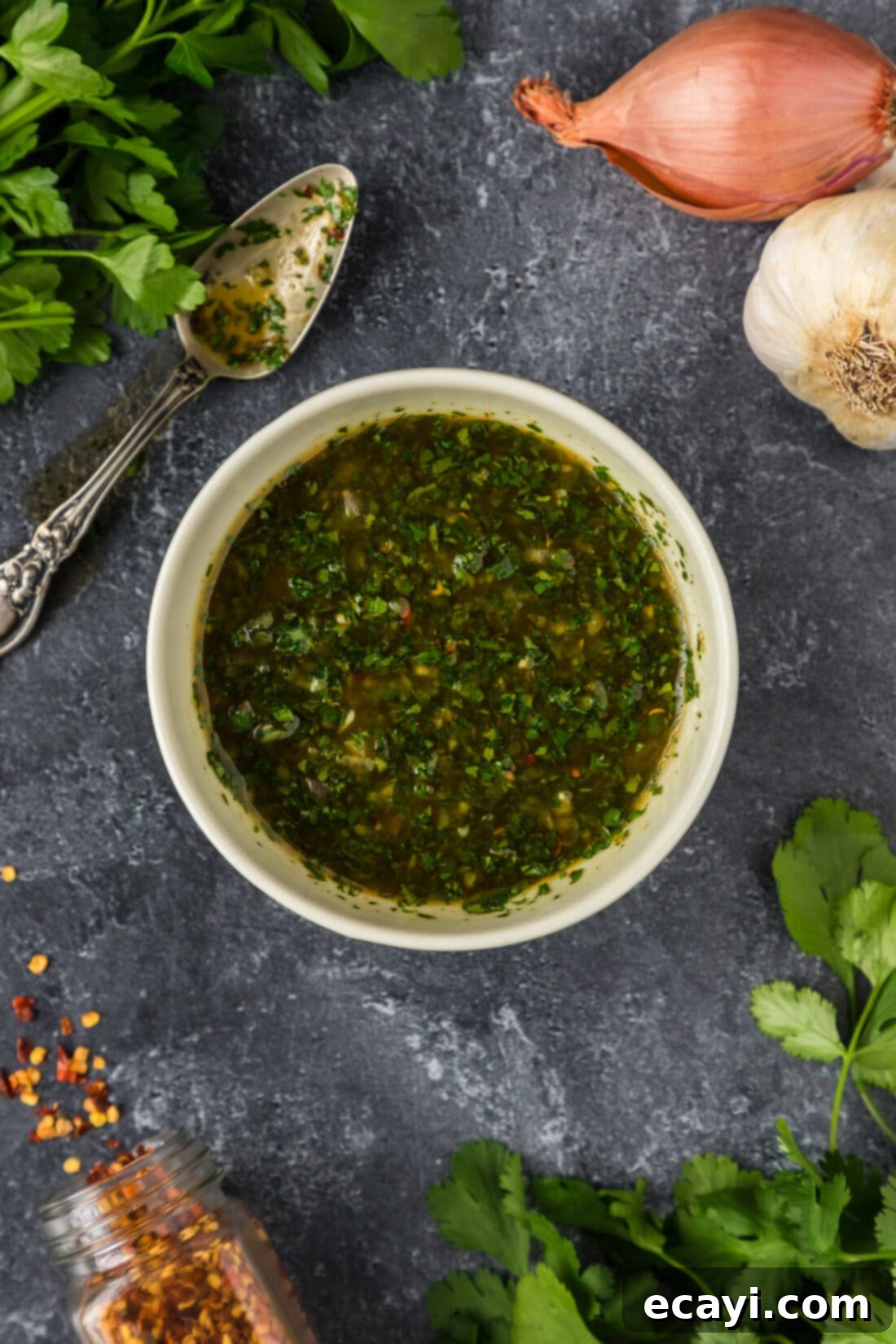
Why This Homemade Chimichurri Recipe Works Wonders
Chimichurri is more than just a sauce; it’s an experience. Originating from Argentina and Uruguay, this uncooked condiment is a staple in South American cuisine, revered for its ability to cut through the richness of grilled meats and add an explosion of fresh flavor. Our version of this classic chimichurri recipe stands out for several compelling reasons:
- Unbeatable Freshness: The secret to a truly outstanding chimichurri lies in the quality of its ingredients. By using only the freshest herbs and aromatics, we ensure a vibrant flavor profile that simply cannot be replicated by dried alternatives. This recipe maximizes that freshness, delivering a sauce that tastes like it came straight from a gourmet kitchen.
- Perfect Balance of Flavors: Our chimichurri sauce achieves a harmonious blend of herbaceous notes, tangy acidity, and a subtle kick of spice. The parsley and cilantro provide the core fresh taste, while garlic and shallots add aromatic depth. The vinegar introduces a crucial bright tang, and a hint of smoked paprika and red pepper flakes round out the profile with warmth and a gentle heat.
- Incredibly Quick and Easy: Despite its complex flavor, this homemade chimichurri is astonishingly simple to prepare. With just a few pulses in a food processor or mini chopper, you can have this exquisite sauce ready in less than 5 minutes. It’s the ideal last-minute addition to any meal, transforming ordinary dishes into extraordinary culinary delights without any fuss.
- Remarkable Versatility: This chimichurri recipe is incredibly adaptable, pairing beautifully with a wide array of dishes. Whether you’re serving it with a perfectly seared steak, drizzling it over roasted vegetables, or simply enjoying it with crusty bread, its refreshing zest will undoubtedly enhance your dining experience. Just like a good pesto, the key is fresh ingredients and a simple approach. Let’s dive into how to create this amazing condiment.
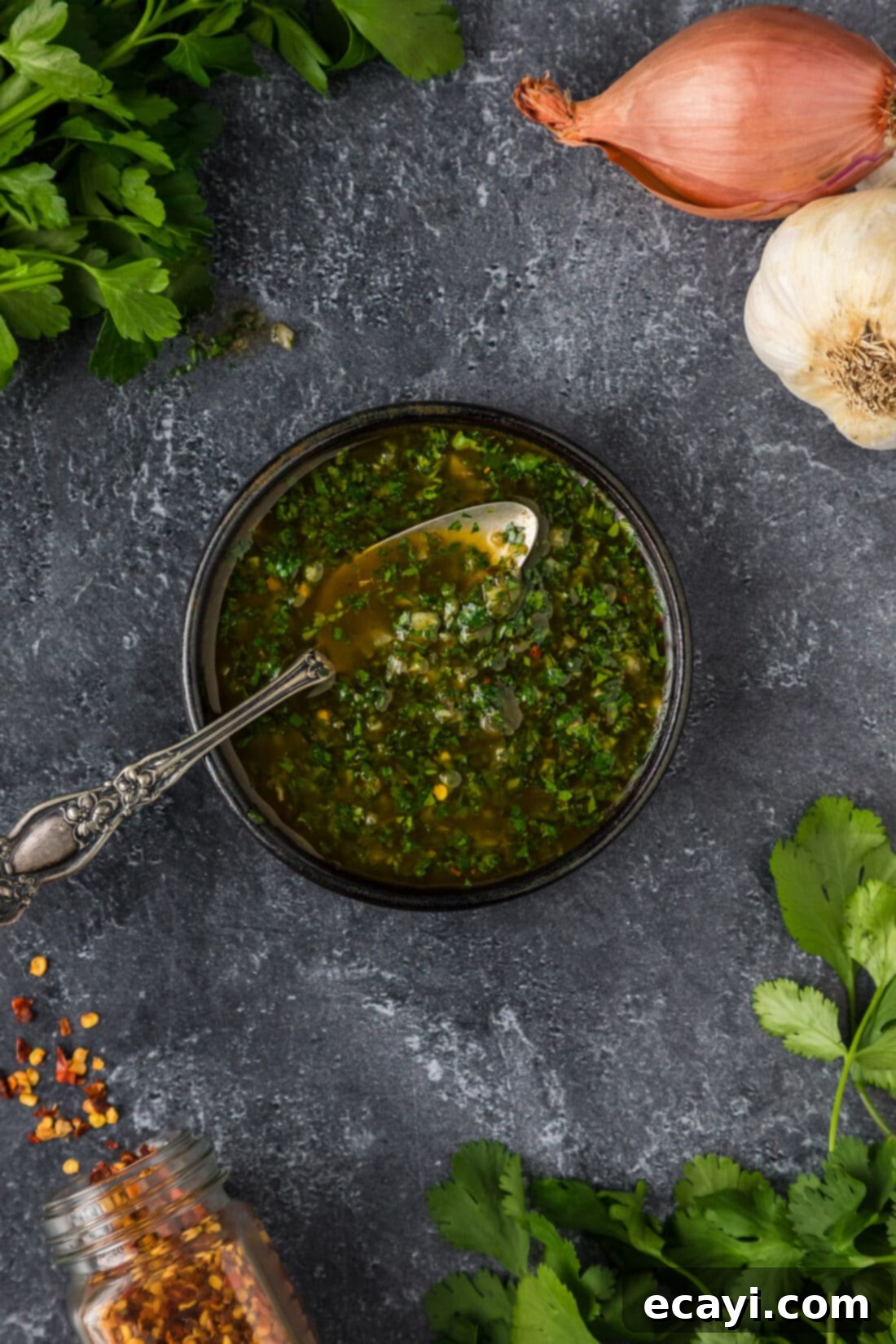
Key Ingredients for Your Perfect Chimichurri Sauce
Crafting the best chimichurri starts with selecting high-quality, fresh ingredients. Each component plays a vital role in achieving that signature vibrant taste and texture. Below is a comprehensive list, but remember, all precise measurements and detailed instructions are available in the printable recipe card at the very end of this post.
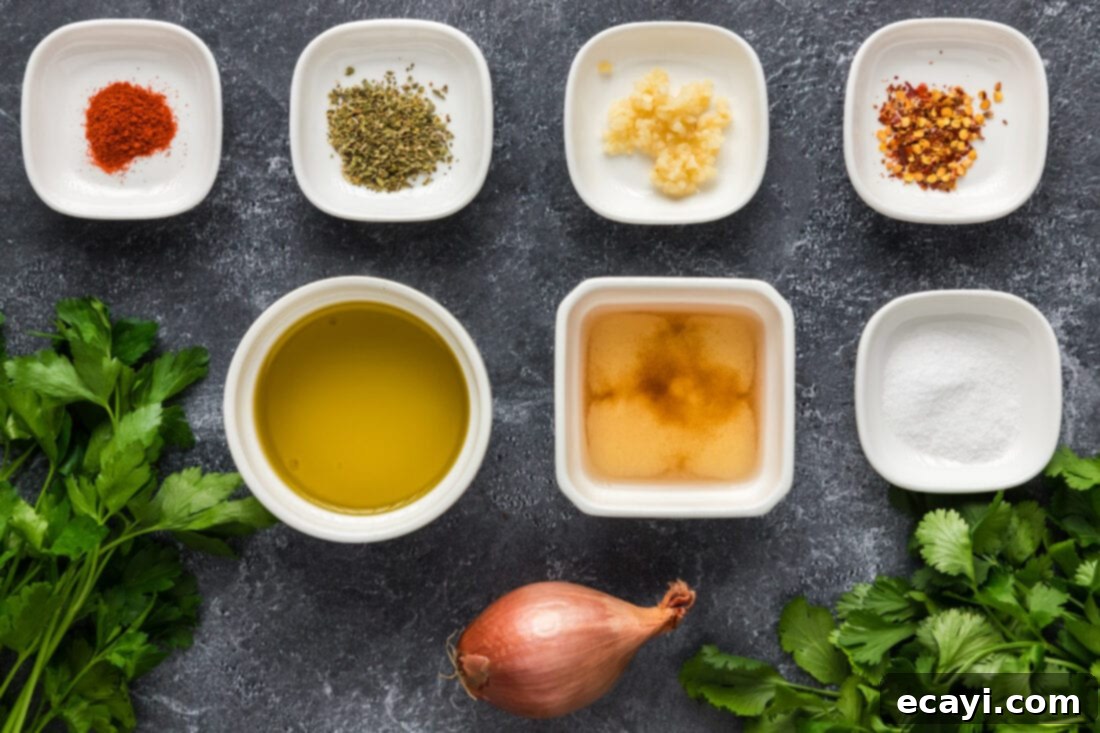
Ingredient Deep Dive and Smart Substitutions
Understanding each ingredient’s role will help you achieve the perfect chimichurri every time and confidently make substitutions when needed:
- Extra Virgin Olive Oil: This is the base of your chimichurri, carrying and melding all the flavors. Use a good quality extra virgin olive oil for the best taste. It should be flavorful but not overpowering.
- Fresh Herbs (Flat-leaf Parsley, Cilantro): These are the stars of chimichurri.
- Flat-leaf parsley (also known as Italian parsley) provides a fresh, slightly peppery, and clean flavor. It’s traditional and essential. Avoid curly parsley, which tends to be less flavorful and can have a tougher texture when chopped.
- Cilantro adds another layer of bright, citrusy, and slightly pungent flavor that is characteristic of many Latin American sauces. If you are not a fan of cilantro (due to the genetic predisposition that makes it taste like soap), you can simply omit it and increase the amount of parsley, or add a little fresh oregano instead.
Tip: Always use fresh herbs. Dried herbs will drastically change the flavor and texture of your chimichurri, losing its vibrant essence. Wash and thoroughly dry your herbs before chopping to avoid a watery sauce.
- Minced Shallot & Minced Garlic: These aromatics provide essential depth and pungency.
- Shallots offer a milder, sweeter onion flavor than traditional onions, making them ideal for raw applications like chimichurri. If you don’t have shallots, a very finely minced red onion (soaked in a little vinegar for 5-10 minutes to reduce its pungency) can be a substitute, but use sparingly.
- Garlic is crucial for that classic robust flavor. Use fresh garlic cloves and mince them finely.
- Vinegar (White Wine or Red Wine Vinegar): This provides the crucial tangy acidity that brightens the sauce and balances the richness of the oil and herbs.
- White wine vinegar is generally milder and has a crisp, bright tang.
- Red wine vinegar is bolder and has a stronger, fruitier, and more robust flavor. Both work exceptionally well in chimichurri, so choose based on your preference for intensity. If you prefer a milder tang, opt for white wine vinegar. For a more pronounced, classic Argentine flavor, red wine vinegar is an excellent choice.
Substitution: Apple cider vinegar can be used in a pinch, but it will impart a slightly different, fruitier flavor. Lemon juice can also add acidity, but vinegar is preferred for authentic taste and preservation.
- Dried Oregano: While fresh herbs are paramount, dried oregano adds a traditional earthy note that complements the fresh flavors. It’s often used in chimichurri, offering a different dimension than fresh oregano would.
- Smoked Paprika: This spice adds a beautiful reddish hue and a subtle smoky, sweet flavor that enhances the overall complexity of the sauce without adding heat. It’s a key ingredient for depth.
- Kosher Salt: Essential for seasoning and bringing out all the flavors. Adjust to your taste, remembering that the salt helps to preserve the sauce slightly.
- Red Pepper Flakes: These provide a gentle warmth and a touch of heat that makes the chimichurri exciting. If you prefer a milder sauce, you can reduce the amount or omit them entirely. For more heat, feel free to add a bit more or even a tiny pinch of finely minced fresh chili pepper.
Simple Steps to Make Your Best Chimichurri
These step-by-step photos and instructions are here to help you visualize how to make this delicious chimichurri recipe. For the complete, printable version of this recipe, including all precise measurements and instructions, scroll down to the dedicated recipe card at the bottom of this post. You can Jump to Recipe to get the printable version of this recipe, complete with measurements and instructions at the bottom.
- Prepare Your Ingredients: Begin by washing and thoroughly drying your fresh flat-leaf parsley and cilantro. It’s crucial that the herbs are dry to prevent the sauce from becoming watery. Mince your shallot and garlic finely. Precision in chopping these aromatics ensures they blend seamlessly into the sauce.
- Combine Most Ingredients: Place all the ingredients into your mini food chopper or food processor, *except* for the red pepper flakes. The reason we add the red pepper flakes separately at the end is to retain their distinct texture and controlled heat, allowing you to adjust spice levels to your preference. Adding them earlier might chop them too finely and disperse the heat more intensely than desired. Ensure all herbs are roughly chopped before adding to the processor to help with even blending.

- Pulse to Perfection: Secure the lid on your food processor or chopper. Pulse 2-3 times, each for about 2 seconds. The goal is to bring all the ingredients together into a vibrant, chunky sauce, not a smooth paste. You want to see distinct flecks of herbs and garlic. Over-processing will result in a muted color, a pasty texture, and can even make the sauce bitter by over-emulsifying the olive oil. Keep an eye on the texture; it should be loose and rustic, showcasing the freshness of the herbs.

- Stir in Red Pepper Flakes: Carefully remove the chimichurri mixture from the food chopper or processor and transfer it to a serving bowl. Now, stir in the red pepper flakes. This ensures they are evenly distributed without being over-processed, preserving their texture and allowing you to adjust the spice level easily. Taste and adjust seasoning with additional salt or vinegar if needed. Some people like a little more tang, others a touch more spice. This is your chance to personalize your perfect chimichurri.
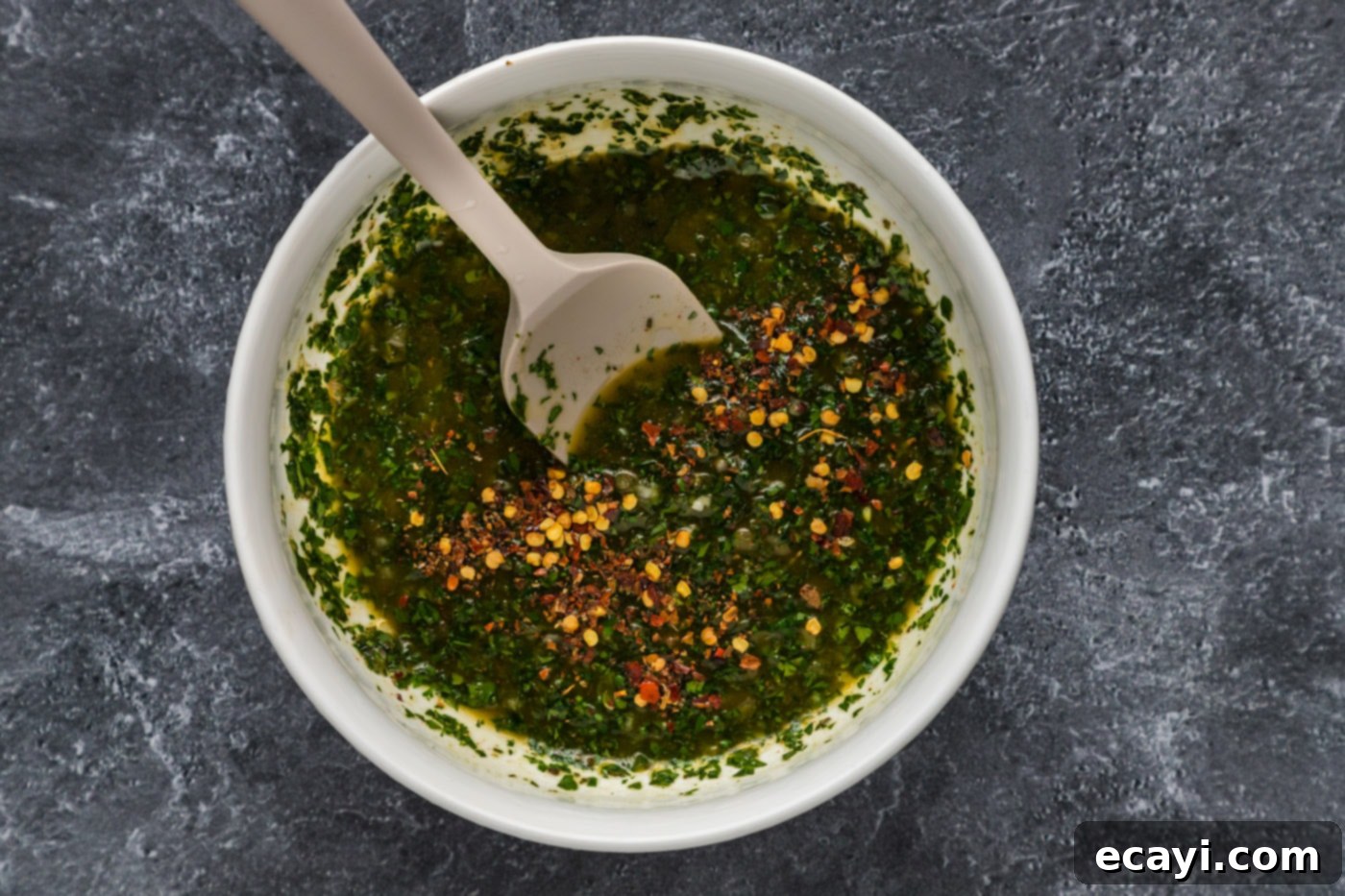
Frequently Asked Questions & Expert Tips for Chimichurri Success
Proper storage is key to maintaining the freshness and flavor of your homemade chimichurri. Store the sauce in an air-tight container or a clean glass jar with a tight-fitting lid. Keep it refrigerated for optimal freshness. It will typically stay fresh and vibrant for up to 4-5 days. Over time, the garlic flavor can intensify, and the herbs may lose some of their brightness, so it’s best enjoyed within the first few days.
Absolutely! Chimichurri freezes beautifully, making it an excellent sauce to prepare in larger batches. To freeze, portion the chimichurri sauce into ice cube trays. Once frozen solid (after a few hours), transfer the chimichurri cubes to a freezer-safe bag or an air-tight container. This method allows you to easily thaw individual portions as needed. Alternatively, you can store the sauce directly in an air-tight container, ensuring there’s a thin layer of olive oil on top to prevent discoloration and freezer burn. Freeze for up to 3 months. To use, simply thaw the desired amount in the refrigerator overnight or on the counter for a couple of hours. Stir well before serving as the oil and solids may separate upon thawing.
Bitterness in chimichurri can often be attributed to over-processing the ingredients in a food processor. When herbs, especially parsley, and garlic are over-blitzed, they can release bitter compounds. The olive oil can also become over-emulsified, leading to a bitter taste and a pasty consistency. To prevent this, pulse the ingredients only 2-3 times for a few seconds each, aiming for a chunky, rustic texture rather than a smooth paste.
Yes, absolutely! While a food processor makes it quicker, traditional chimichurri is often made by hand. Finely chop all your fresh herbs, garlic, and shallots with a sharp knife. Then, combine them in a bowl with the olive oil, vinegar, and spices, mixing everything together until well combined. This method might take a bit longer but often results in an even more rustic and satisfying texture.
The spice level of your chimichurri is easily customizable. If you prefer a milder sauce, simply reduce the amount of red pepper flakes or omit them entirely. For those who love a fiery kick, you can increase the red pepper flakes or add a small amount of finely minced fresh chili, such as serrano or jalapeño, to the mixture.
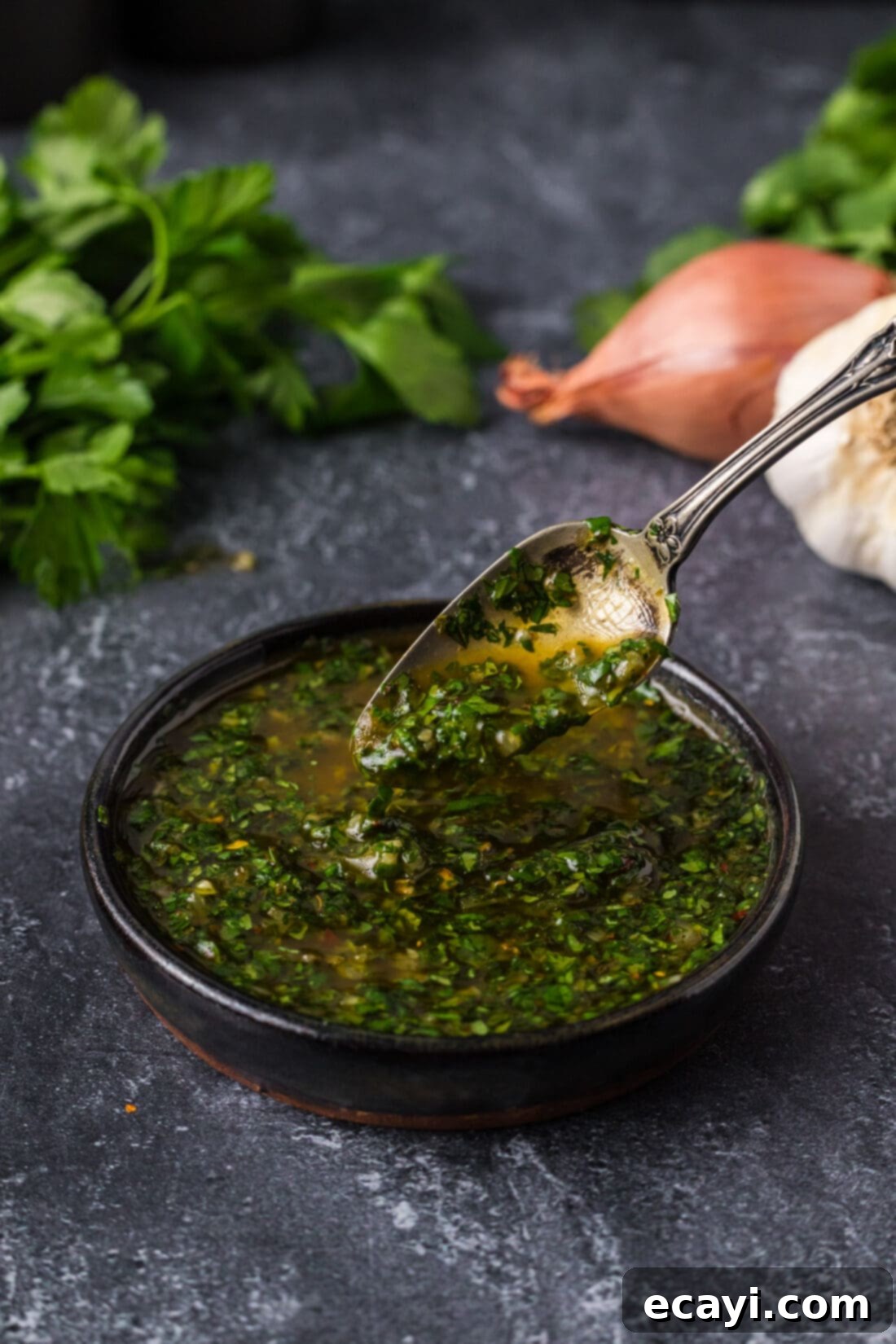
Delightful Serving Suggestions for Chimichurri
The beauty of chimichurri lies in its incredible versatility. This bright, herbaceous sauce can elevate almost any savory dish, transforming simple ingredients into a gourmet experience. Here are some of our favorite ways to enjoy this fantastic homemade chimichurri:
- Grilled Meats: This is the classic pairing! Chimichurri is famously served alongside grilled steak (like flank, skirt, or ribeye), offering a zesty counterpoint to the rich, charred flavors. It’s also sensational with grilled chicken, pork chops, lamb, or even seafood like grilled shrimp or fish fillets. You can use it as a finishing sauce, spooning it generously over the cooked meat, or even as a short marinade (for no more than 30 minutes, as the vinegar can “cook” the meat if left too long).
- Roasted Vegetables: Drizzle chimichurri over hot, tender roasted vegetables for an instant flavor boost. Think roasted potatoes, asparagus, broccoli, cauliflower, carrots, or bell peppers. The fresh herbs and tangy vinegar brighten up the earthy sweetness of the vegetables.
- Crusty Bread: A simple yet incredibly satisfying way to enjoy chimichurri is to serve it as a dip with chunks of warm, crusty bread or a fresh baguette. The bread soaks up all the flavorful oil and herbs, making for a delicious appetizer or side.
- Sandwiches and Wraps: Spread a spoonful of chimichurri inside your favorite sandwich, wrap, or even a burger. It adds a fresh, zesty kick that takes these everyday meals to a new level. Try it with a grilled chicken sandwich or a veggie wrap.
- Eggs: Don’t knock it ’til you try it! A dollop of chimichurri over scrambled eggs, fried eggs, or an omelet can add an unexpected layer of fresh, savory flavor, making your breakfast or brunch truly special.
- Salad Dressing: Thin out your chimichurri with a little extra olive oil or vinegar if desired, and use it as a vibrant dressing for green salads or grain bowls. It’s a healthier and more flavorful alternative to many store-bought dressings.
- Marinade: While typically a finishing sauce, chimichurri also makes a fantastic marinade for poultry or firm vegetables. Just be mindful of the vinegar content and marinate for shorter periods (around 15-30 minutes for chicken or fish) to avoid over-tenderizing.
- Pasta Sauce: Toss freshly cooked pasta with a generous amount of chimichurri for a quick, flavorful, and light meal. Add some grated Parmesan cheese if you wish.
No matter how you choose to enjoy it, this homemade chimichurri sauce is guaranteed to add a burst of vibrant flavor to your culinary creations.
More Related Flavorful Sauce Recipes
If you loved making this chimichurri, you might also enjoy exploring other versatile and delicious homemade sauces:
- Classic Basil Pesto
- Homemade Garlic Butter Sauce
- Rich Rosemary Cream Sauce
- Zesty Sun Dried Tomato Pesto
- Creamy Garlic Aioli
I love to bake and cook and share my kitchen experience with all of you! Remembering to come back each day can be tough, that’s why I offer a convenient newsletter every time a new recipe posts. Simply subscribe and start receiving your free daily recipes!
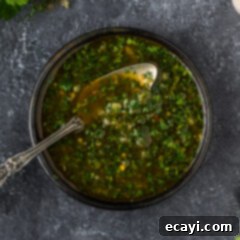
Classic Homemade Chimichurri Sauce
IMPORTANT – There are often Frequently Asked Questions within the blog post that you may find helpful. Simply scroll back up to read them!
Print It
Pin It
Rate It
Save ItSaved!
Ingredients
- ⅓ cup extra virgin olive oil
- 1 ½ Tablespoons minced shallot
- 1 teaspoon minced garlic
- 3 Tablespoons white wine vinegar
- ¼ teaspoon smoked paprika
- ½ teaspoon Kosher salt
- ¼ cup finely chopped cilantro
- ⅓ cup finely chopped flat-leaf parsley
- ½ teaspoon dried oregano
- ¼ teaspoon red pepper flakes
Things You’ll Need
-
Mini food chopper or food processor
-
Rubber spatula
Before You Begin
- For the best authentic flavor, ensure all your herbs are fresh and thoroughly dried after washing.
- White wine vinegar offers a crisp, brighter tang, while red wine vinegar provides a bolder, more robust flavor. Both pair wonderfully with the herbaceous notes of this chimichurri. Choose based on your preferred intensity.
Instructions
-
Place all ingredients, *except red pepper flakes*, into a mini food chopper or food processor. Pulse the mixture 2-3 times for 2 seconds at a time. The goal is to combine the ingredients into a chunky sauce, not a smooth paste. Be careful not to over-process.
-
Remove the chimichurri mixture from the chopper/processor to a bowl. Stir in the red pepper flakes. Taste and adjust seasoning as needed, adding more salt or vinegar to your preference.
Expert Tips & FAQs
- Storage: Store the chimichurri sauce in an air-tight container or jar in the refrigerator for up to 4 days. A thin layer of olive oil on top can help preserve its color and freshness.
- Freezing: Chimichurri freezes well. Portion the sauce into ice cube trays and freeze until solid. Transfer the frozen cubes to a freezer-safe bag or container and store for up to 3 months. Thaw in the refrigerator before use.
- Texture is Key: Avoid over-processing the ingredients. A chunky, rustic texture is ideal for chimichurri, ensuring each bite delivers a burst of fresh flavor.
- Freshness First: Always opt for fresh herbs and garlic. Dried alternatives will significantly alter the authentic taste and vibrant character of the sauce.
- Taste and Adjust: Don’t be afraid to taste your chimichurri and adjust the salt, vinegar, or red pepper flakes to suit your palate. This personalization is what makes homemade sauces truly special.
Nutrition
The recipes on this blog are tested with a conventional gas oven and gas stovetop. It’s important to note that some ovens, especially as they age, can cook and bake inconsistently. Using an inexpensive oven thermometer can assure you that your oven is truly heating to the proper temperature. If you use a toaster oven or countertop oven, please keep in mind that they may not distribute heat the same as a conventional full sized oven and you may need to adjust your cooking/baking times. In the case of recipes made with a pressure cooker, air fryer, slow cooker, or other appliance, a link to the appliances we use is listed within each respective recipe. For baking recipes where measurements are given by weight, please note that results may not be the same if cups are used instead, and we can’t guarantee success with that method.
